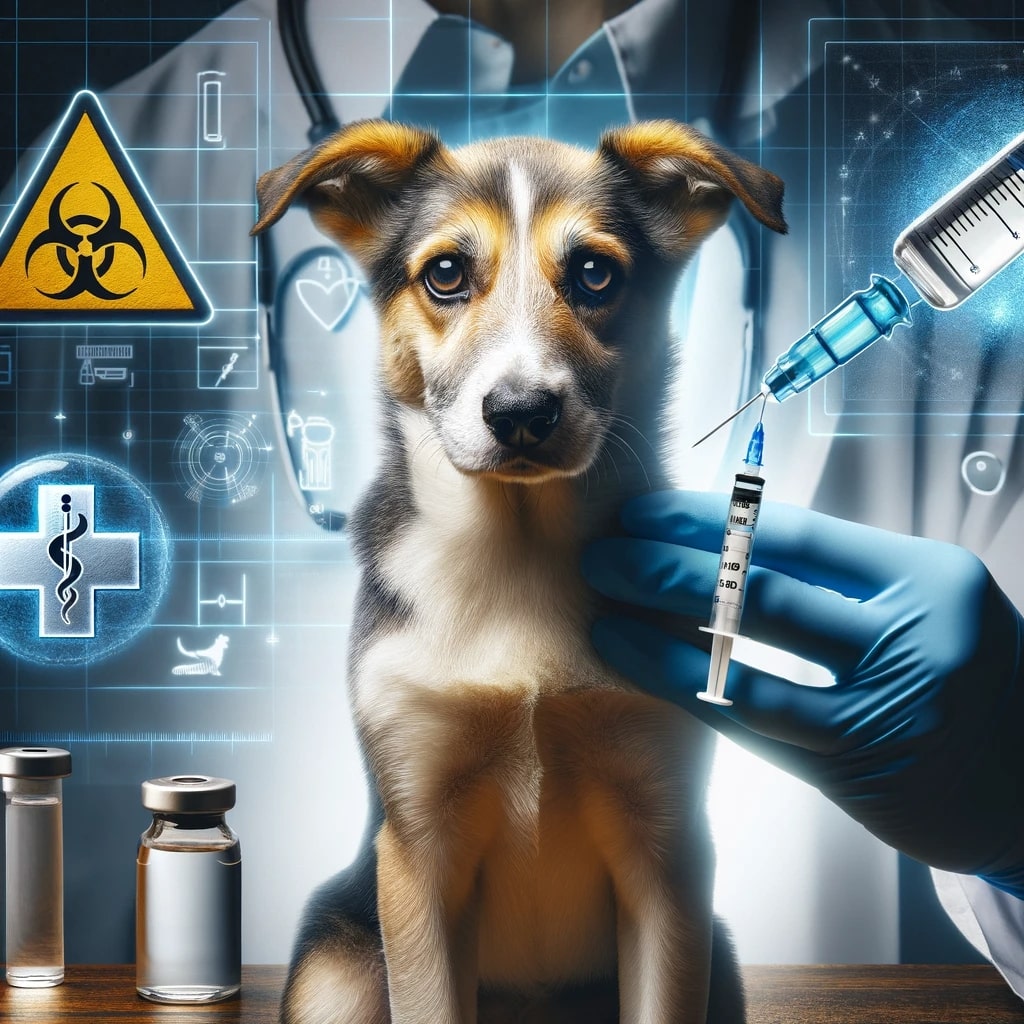Sporotrichosis is a relatively rare but significant fungal infection that can affect dogs, as well as other animals and humans. This comprehensive guide aims to address the most common concerns and questions about this disease, providing in-depth information to help pet owners understand and manage this condition effectively.
1. What is Sporotrichosis and How Does it Affect Dogs?
Sporotrichosis is a fungal infection caused by the Sporothrix schenckii fungus. It primarily affects the skin, although it can spread to other parts of the body. This disease is notable for its nodular skin lesions, which can ulcerate and discharge pus.
Understanding the Disease
- Etiology: Sporotrichosis is caused by the fungus Sporothrix schenckii.
- Transmission: The fungus lives in soil and vegetation. Dogs typically get infected through direct contact with contaminated material, often via skin wounds.
Clinical Signs
- Skin Lesions: The most common manifestation is nodular lesions that may ulcerate.
- Lymphatic Involvement: The infection can spread along lymphatic vessels, causing nodular chains.
- Systemic Symptoms: In disseminated cases, dogs may exhibit lethargy, fever, and joint pain.
Diagnosis
- Diagnostic procedures include cytology, culture of the fungus, and histopathology.
- Blood tests and imaging may be used to assess systemic involvement.
Treatment Options
- Antifungal medications, such as Itraconazole, are the mainstay of treatment.
- Treatment duration is typically prolonged, often several months.
- Surgical debridement may be necessary for severe cases.
Prevention Strategies
- Avoiding environments with a high risk of Sporothrix schenckii exposure, like heavily wooded areas or places with decaying vegetation.
- Protective clothing and grooming to minimize skin wounds.
Prognosis
- With appropriate treatment, the prognosis is generally good for localized infections.
- Disseminated infections may have a more guarded prognosis.
2. What are the Early Signs of Sporotrichosis in Dogs?
Early detection of sporotrichosis in dogs is crucial for effective treatment and management. Recognizing the initial symptoms can help in seeking timely veterinary care.
Initial Symptoms
- Small, Raised Bumps: These bumps, or nodules, often appear on the skin, particularly on the limbs or face.
- Lack of Pain or Itching: Unlike other skin conditions, sporotrichosis lesions are typically not painful or itchy.
- Ulceration: The nodules may ulcerate, forming open sores that discharge a clear or pus-filled fluid.
Progression of Symptoms
- Spread Along Lymph Nodes: The nodules may develop along the lymphatic channels.
- General Ill-health: In advanced cases, symptoms like fever, lethargy, and weight loss may occur.
Differential Diagnosis
- Conditions like bacterial or fungal infections, insect bites, and cancer should be considered.
- A thorough diagnostic workup is necessary to differentiate sporotrichosis from other conditions.
Importance of Veterinary Consultation
- Early veterinary intervention is crucial.
- A veterinarian will perform a physical examination and recommend diagnostic tests.
Diagnostic Methods
- Cytology: Microscopic examination of fluid or tissue samples from lesions.
- Culture: Growing the fungus from a sample to confirm the diagnosis.
- Histopathology: Examining tissue samples for characteristic fungal elements.
Monitoring and Follow-up
- Regular monitoring of the disease progression.
- Follow-up visits to assess the response to treatment.
Impact on Quality of Life
- Early-stage sporotrichosis is less likely to affect the dog’s overall quality of life significantly.
- Prompt treatment can prevent complications that might arise from advanced disease.
Owner’s Role in Early Detection
- Regularly checking your dog for unusual skin lesions or bumps.
- Maintaining a record of any changes in your dog’s health or behavior.
3. How is Sporotrichosis Diagnosed in Dogs?
Diagnosing sporotrichosis in dogs involves a series of steps to confirm the presence of the Sporothrix schenckii fungus and to assess the extent of the infection.
Clinical Examination
- A thorough physical examination, focusing on skin lesions and lymph nodes.
Diagnostic Testing
- Cytology: Examining samples from lesions under a microscope.
- Culture: Culturing the pathogen from lesion samples.
- Histopathology: Tissue biopsy to identify fungal elements.
- Serology: Blood tests to detect antibodies against Sporothrix schenckii, although this is less commonly used in dogs.
Imaging Studies
- X-rays, ultrasound, or CT scans may be needed to evaluate internal organ involvement in disseminated cases.
Differential Diagnosis
- Differentiating from other skin diseases like bacterial infections, other fungal infections, insect bites, and neoplasia.
Importance of Accurate Diagnosis
- Accurate diagnosis is crucial for effective treatment.
- Misdiagnosis can lead to ineffective treatments and worsening of the condition.
Role of the Veterinarian
- Veterinarians play a key role in diagnosing and devising a treatment plan.
- They will consider the dog’s overall health, history, and clinical signs.
Laboratory Collaboration
- Samples may be sent to specialized laboratories for confirmation.
- Collaboration with pathologists and microbiologists can provide a definitive diagnosis.
Follow-up Testing
- Regular follow-up tests to monitor the response to treatment.
- Adjustments to the treatment plan based on these results.
Owner’s Participation
- Providing detailed information about the dog’s health history and symptoms.
- Following through with recommended diagnostic tests and follow-up appointments.
Cost and Accessibility
- Some diagnostic tests can be costly and may require referral to a specialist.
- Owners should discuss cost and treatment options with their veterinarian.
Timeframe for Diagnosis
- Some tests, like culture, may take several days or weeks to yield results.
- Early diagnosis and treatment initiation are crucial for a better prognosis.
4. What Treatment Options are Available for Dogs with Sporotrichosis?
Treating sporotrichosis in dogs requires a comprehensive approach, involving antifungal medications and supportive care.
Antifungal Medications
- Itraconazole: The most commonly used antifungal medication for sporotrichosis.
- Alternative Medications: Ketoconazole, Terbinafine, and Amphotericin B may be used in certain cases.
Treatment Duration
- Treatment often lasts several months.
- The duration depends on the severity of the disease and the dog’s response to treatment.
Monitoring Treatment Efficacy
- Regular veterinary check-ups to monitor the dog’s response to treatment.
- Adjustments to medication may be necessary based on these evaluations.
Supportive Care
- Wound care for ulcerated lesions.
- Nutritional support to bolster the dog’s immune system.
Potential Side Effects
- Antifungal medications can have side effects, including liver toxicity.
- Regular blood tests may be necessary to monitor liver function.
Importance of Completing Treatment
- It’s crucial to complete the full course of treatment to prevent relapse.
- Stopping treatment early can lead to drug resistance.
Surgical Intervention
- In severe cases, surgical removal of lesions may be necessary.
- This is usually considered when medical treatment alone is not effective.
Home Care
- Owners should follow veterinary instructions for administering medications and wound care.
- Keeping the dog in a clean and comfortable environment aids recovery.
Cost Considerations
- Treatment for sporotrichosis can be costly due to the length of treatment and frequent veterinary visits.
- Owners should discuss financial options with their veterinarian.
Prognosis with Treatment
- With early and appropriate treatment, the prognosis is generally good.
- In cases with systemic involvement, the prognosis can be more guarded.
5. How Can Sporotrichosis Be Prevented in Dogs?
Preventing sporotrichosis in dogs involves minimizing their exposure to the fungus and maintaining good overall health.
Environmental Management
- Avoid areas known to be contaminated with Sporothrix schenckii, like wooded areas or places with decaying vegetation.
- Regularly clean areas where the dog spends time to reduce fungal exposure.
Wound Care
- Prompt treatment of any skin wounds to prevent infection.
- Regular skin checks for any abnormalities or injuries.
Good Hygiene Practices
- Bathing and grooming the dog regularly.
- Using antifungal shampoos may be beneficial in endemic areas.
Strengthening Immunity
- A balanced diet to maintain a strong immune system.
- Regular exercise and proper veterinary care.
Education and Awareness
- Educating dog owners about sporotrichosis, especially in endemic areas.
- Recognizing early signs and seeking timely veterinary care.
Quarantine and Isolation
- Isolating infected animals to prevent the spread to other pets or humans.
- Following veterinary advice on quarantine procedures.
Regular Veterinary Check-ups
- Routine health check-ups can help in early detection of various conditions, including sporotrichosis.
- Discussing preventive measures with the veterinarian.
Vaccination and Medication
- Currently, there are no vaccines available for sporotrichosis in dogs.
- Prophylactic antifungal medication is not typically recommended due to potential side effects and the rarity of the disease.
Community and Public Health Measures
- Reporting cases to local health authorities can help in monitoring and controlling outbreaks.
- Community education programs about fungal diseases and their prevention.
Research and Development
- Supporting research on sporotrichosis can lead to better prevention and treatment strategies.
- Development of vaccines or more effective treatments could significantly reduce the incidence of the disease.
6. Is Sporotrichosis Contagious to Other Pets or Humans?
Understanding the zoonotic potential of sporotrichosis is crucial for pet owners and those who are in close contact with infected animals.
Zoonotic Potential
- Sporotrichosis is a zoonotic disease, meaning it can be transmitted from animals to humans and vice versa.
- Transmission typically occurs through direct contact with the lesions of an infected animal.
Risk to Other Pets
- Other pets can be infected if they come into contact with the fungal elements from an infected dog.
- Cats are particularly susceptible to sporotrichosis.
Human Infection
- Humans can contract sporotrichosis by handling an infected dog, especially if they have open wounds or scratches.
- Gardeners and people working with soil or plants are also at risk.
Safety Precautions
- Wearing gloves and protective clothing when handling infected animals.
- Washing hands thoroughly after contact.
Quarantine Measures
- Isolating the infected dog from other pets and family members.
- Limiting the dog’s movement in shared spaces.
Medical Consultation for Humans
- Seeking medical advice if a person develops symptoms after contact with an infected dog.
- Early diagnosis and treatment are important for humans, just as they are for pets.
Awareness and Education
- Educating all members of the household about the risks and preventive measures.
- Awareness of the signs and symptoms in both pets and humans.
Reporting and Collaboration
- Reporting cases to health authorities for monitoring and control measures.
- Collaboration between veterinarians and human health professionals.
Environmental Decontamination
- Regular cleaning and disinfecting of areas where the infected dog has been.
- Proper disposal of contaminated materials.
Community Health Implications
- Understanding the public health implications of sporotrichosis in endemic areas.
- Community-wide efforts to control and prevent the spread of the disease.
Long-Term Management
- Ongoing monitoring of pets and humans who have been in contact with the infected dog.
- Regular veterinary and medical check-ups for early detection and treatment.
7. What are the Long-Term Effects of Sporotrichosis on Dogs?
Considering the long-term health implications of sporotrichosis is important for managing the overall wellbeing of affected dogs.
Chronic Infection
- Sporotrichosis can become a chronic condition in some dogs.
- Long-term medication and management may be necessary.
Impact on General Health
- Chronic sporotrichosis can affect a dog’s overall health and quality of life.
- Secondary infections and complications can arise from weakened immunity.
Ongoing Medical Care
- Regular veterinary visits to monitor the disease progression.
- Adjustments in treatment plans based on the dog’s response.
Potential Complications
- Disseminated sporotrichosis can affect internal organs, leading to more serious health issues.
- Joint pain, eye problems, and respiratory issues can occur in severe cases.
Impact on Mobility
- Lesions on limbs can affect a dog’s mobility and comfort.
- Physical therapy and pain management may be necessary.
Nutritional Support
- A balanced diet to support healing and boost immunity.
- Supplements may be recommended by the veterinarian.
Mental and Emotional Well-being
- Chronic diseases can affect a dog’s mood and behavior.
- Providing a comfortable and stress-free environment is essential.
Owner’s Responsibility
- Long-term commitment to the care and management of a dog with sporotrichosis.
- Understanding the emotional and financial aspects of chronic disease management.
Rehabilitation and Recovery
- Some dogs may recover completely with no lasting effects.
- Rehabilitation programs may be necessary for those with physical impairments.
Quality of Life Considerations
- Regular assessments of the dog’s quality of life.
- Making informed decisions about ongoing care and treatment options.
8. Can Sporotrichosis in Dogs be Cured Completely?
Exploring the potential for a complete cure of sporotrichosis in dogs is important for setting realistic expectations and planning long-term care.
Curative Potential
- Many cases of sporotrichosis in dogs can be cured with appropriate treatment.
- Complete resolution of symptoms is possible, especially with early diagnosis and treatment.
Factors Influencing Cure
- The severity of the infection and the dog’s overall health play a crucial role.
- Early and aggressive treatment increases the chances of a complete cure.
Treatment Compliance
- Adherence to the treatment regimen is essential for a successful outcome.
- Incomplete or inconsistent treatment can lead to relapse or drug resistance.
Monitoring and Follow-up
- Regular follow-up visits to assess the response to treatment.
- Adjustments to the treatment plan based on the dog’s progress.
Recurrence Risk
- There is a risk of recurrence, especially if the underlying factors are not addressed.
- Long-term monitoring is necessary to detect and treat any recurrence promptly.
Impact of Early Intervention
- The earlier the treatment is started, the better the chances of a complete cure.
- Recognizing the signs and seeking timely veterinary care are crucial.
Role of Immune System
- A dog’s immune system plays a significant role in overcoming the infection.
- Immune-compromised dogs may have a more challenging recovery.
Post-Treatment Care
- Post-treatment care is essential to prevent recurrence.
- This may include environmental management and ongoing health monitoring.
Psychological Impact on the Dog
- Chronic illnesses can affect a dog’s mental and emotional well-being.
- Supportive care, including mental stimulation and comfort, is important.
Communication with Veterinarians
- Open and regular communication with veterinarians is key to successful treatment and recovery.
- Discussing concerns, treatment options, and prognosis helps in making informed decisions.
9. What are the Risks and Complications Associated with Sporotrichosis Treatment in Dogs?
Understanding the risks and potential complications of treating sporotrichosis in dogs is important for managing the disease effectively and safely.
Medication Side Effects
- Antifungal drugs can cause side effects, including liver toxicity, gastrointestinal upset, and skin reactions.
- Regular blood tests may be required to monitor liver function and drug levels.
Drug Interactions
- Some antifungal medications can interact with other drugs.
- It’s important to inform the veterinarian about all medications the dog is taking.
Resistance to Treatment
- In some cases, the fungus may develop resistance to antifungal medications.
- This can lead to treatment failure and necessitate a change in medication.
Treatment Duration
- Long-term treatment can be challenging for both the dog and the owner.
- Compliance and persistence are key to successful treatment.
Cost of Treatment
- The cost of long-term medication and veterinary care can be significant.
- Financial planning and discussion with the veterinarian are important.
Surgical Risks
- In cases requiring surgical intervention, there are risks associated with anesthesia and surgery.
- Postoperative care is crucial for recovery.
Impact on Immune System
- Long-term use of certain medications can impact the immune system.
- This may make the dog more susceptible to other infections.
Emotional and Psychological Impact
- The stress of ongoing treatment can affect both the dog and the owner.
- Supportive care and stress management are important.
Monitoring for Complications
- Regular veterinary check-ups are necessary to monitor for any complications.
- Early detection and management of complications can improve the outcome.
Informed Decision-Making
- Understanding the risks and benefits of treatment options is crucial.
- Involvement in the treatment decision-making process helps in managing the disease effectively.
10. How Does Sporotrichosis Affect a Dog’s Lifestyle and Activities?
The impact of sporotrichosis on a dog’s daily life and activities can vary depending on the severity of the disease and the effectiveness of the treatment.
Activity Level
- Dogs with sporotrichosis may experience reduced activity levels, especially if they have painful lesions.
- Adjusting exercise routines to accommodate the dog’s comfort level is important.
Interaction with Other Animals
- Infected dogs may need to be isolated from other pets to prevent transmission.
- This can affect their social interactions and mental health.
Outdoor Activities
- Limiting exposure to environments where the fungus is prevalent is recommended.
- This may mean altering the dog’s usual outdoor activities.
Diet and Nutrition
- A balanced diet is essential for supporting the dog’s immune system during treatment.
- Dietary adjustments may be necessary based on the dog’s health and treatment side effects.
Grooming and Care
- Regular grooming is important, but care must be taken with lesions.
- Wound care and hygiene are crucial parts of treatment.
Travel and Boarding
- Travel may be restricted, especially if the dog requires ongoing treatment.
- Boarding facilities may not accept dogs with sporotrichosis due to the risk of transmission.
Quality of Life
- The disease and its treatment can impact the dog’s quality of life.
- Regular assessments and adjustments to care plans are important to ensure the best possible quality of life.
Owner’s Lifestyle
- Caring for a dog with sporotrichosis can require significant time and resources.
- Owners may need to adjust their routines to accommodate their dog’s needs.
Emotional Bond
- The experience can strengthen the bond between the dog and the owner.
- Providing comfort and care during this time is crucial for the dog’s well-being.
Long-Term Outlook
- With successful treatment, many dogs can return to a normal lifestyle.
- Ongoing monitoring and care are necessary to maintain health and prevent recurrence.
Key Takeaways
- Early Detection and Diagnosis: Recognizing the symptoms early and obtaining a proper diagnosis are crucial for effective treatment.
- Comprehensive Treatment: Treatment typically involves long-term antifungal medication, monitoring for side effects, and supportive care.
- Prevention Strategies: Minimizing exposure to the fungus, good hygiene practices, and regular veterinary check-ups can help prevent sporotrichosis.
- Owner’s Role: Pet owners play a critical role in the treatment and management of sporotrichosis, from administering medication to providing a supportive environment.
- Quality of Life: With appropriate care, most dogs with sporotrichosis can maintain a good quality of life.
Encouragement for Pet Owners
Dealing with a pet’s illness can be challenging, but understanding the condition and being proactive in its management can make a significant difference. Regular communication with your veterinarian, adherence to treatment protocols, and providing a loving and supportive home are key to helping your dog overcome sporotrichosis.
Ongoing Research and Hope
The veterinary community continues to research sporotrichosis to improve diagnostic methods, treatment options, and preventive measures. Advances in veterinary medicine bring hope for even more effective management of this disease in the future.
Community Support
Remember, you are not alone in this journey. There are communities and support groups where you can share experiences, gain insights, and receive encouragement from others who have faced similar challenges.
Final Thoughts
While sporotrichosis can be a serious condition, with the right approach and care, dogs can lead happy, fulfilling lives. As pet owners, our awareness, vigilance, and dedication play a vital role in the health and well-being of our furry companions.
Emphasizing Regular Veterinary Care
It’s important to emphasize the role of regular veterinary care in both preventing and managing sporotrichosis. Routine check-ups can help catch not only sporotrichosis but also other health issues early, when they’re often easier to treat.
The Role of Community Awareness
Raising awareness about sporotrichosis in the community, especially in areas where it’s more common, can help in early detection and treatment. This can be achieved through local veterinary clinics, pet-related events, and educational campaigns.
Adapting to a New Normal
For dogs diagnosed with sporotrichosis, and their owners, adapting to the changes in lifestyle and care routines can be challenging but necessary. Embracing this new normal with patience and understanding is key to managing the disease effectively.
The Importance of Mental Health
The mental health of both the dog and the owner is important during the treatment of sporotrichosis. Stress reduction techniques, such as gentle exercise, quality time together, and, if necessary, professional support, can be beneficial.
Financial Planning and Resources
Since treatment for sporotrichosis can be lengthy and potentially expensive, financial planning is crucial. Exploring options like pet insurance, payment plans, or charitable organizations can provide support in managing costs.
The Power of a Supportive Community
Joining support groups, either in person or online, can provide emotional support and practical advice for managing sporotrichosis. Sharing experiences with others who understand can be incredibly comforting and helpful.
Ongoing Education
Continuing to educate oneself about sporotrichosis and general pet health is important. Staying informed about the latest research and treatment options can help pet owners make the best decisions for their pets.
Celebrating Small Victories
Throughout the treatment process, it’s important to celebrate small victories. Whether it’s a positive response to treatment or an especially good day, acknowledging these moments can provide encouragement and hope.
Reflecting on the Journey
Dealing with a chronic condition like sporotrichosis can be a journey filled with challenges, but also growth and deepened bonds. Reflecting on this journey can bring perspective and appreciation for the resilience of both the pet and the owner.
Looking Ahead
While sporotrichosis requires careful management, with the advancements in veterinary medicine and supportive care, there is much hope for affected dogs to lead happy and comfortable lives. Looking ahead with optimism and preparedness is the way forward for pet owners navigating this condition.
Summary Table of Sporotrichosis in Dogs
| Aspect | Details |
| What is Sporotrichosis? | A fungal infection caused by Sporothrix schenckii, affecting the skin and sometimes other body parts. |
| Early Signs | Small, raised bumps on skin, lack of pain or itching, potential ulceration. |
| Diagnosis | Through clinical examination, cytology, culture, histopathology, and imaging studies. |
| Treatment Options | Antifungal medications (e.g., Itraconazole), supportive care, and possibly surgical intervention. |
| Prevention | Avoidance of high-risk areas, wound care, good hygiene, strengthening immunity. |
| Contagiousness | Yes, it can be transmitted to other pets and humans through contact with lesions. |
| Long-Term Effects | Potential for chronic infection, impact on general health, ongoing medical care. |
| Cure Possibility | Often curable with proper treatment, though some factors influence the likelihood of a complete cure. |
| Treatment Risks/Complications | Side effects from medication, drug interactions, resistance to treatment. |
| Lifestyle Impact | Changes in activity level, interaction restrictions, dietary and care adjustments. |
Frequently Asked Questions
Small raised bumps on the skin, particularly on the limbs or face, which may ulcerate. These lesions typically do not cause pain or itching.
It is primarily transmitted through direct contact with contaminated material like soil and vegetation, often via skin wounds.
Treatment typically involves long-term administration of antifungal medications such as Itraconazole, alongside supportive care.
Yes, it can be transmitted to humans through direct contact with the lesions of an infected dog.
Treatment duration can vary but often lasts several months, depending on the severity and response to medication.
Many dogs can fully recover with proper treatment, especially if the disease is caught and treated early.
Preventive measures include avoiding high-risk areas, proper wound care, maintaining good hygiene, and ensuring a strong immune system through a balanced diet.
Conclusion
Sporotrichosis in dogs is a serious but manageable condition. Early detection, appropriate treatment, and preventive measures play crucial roles in ensuring the health and well-being of affected dogs. With commitment and care, dogs with sporotrichosis can lead comfortable and happy lives.



